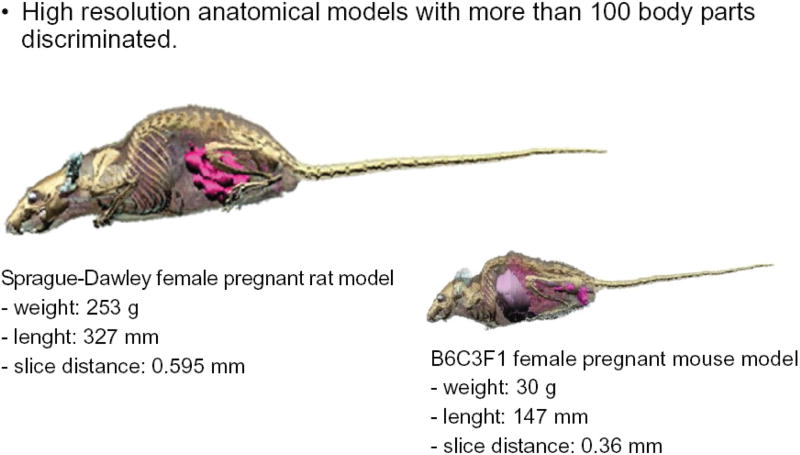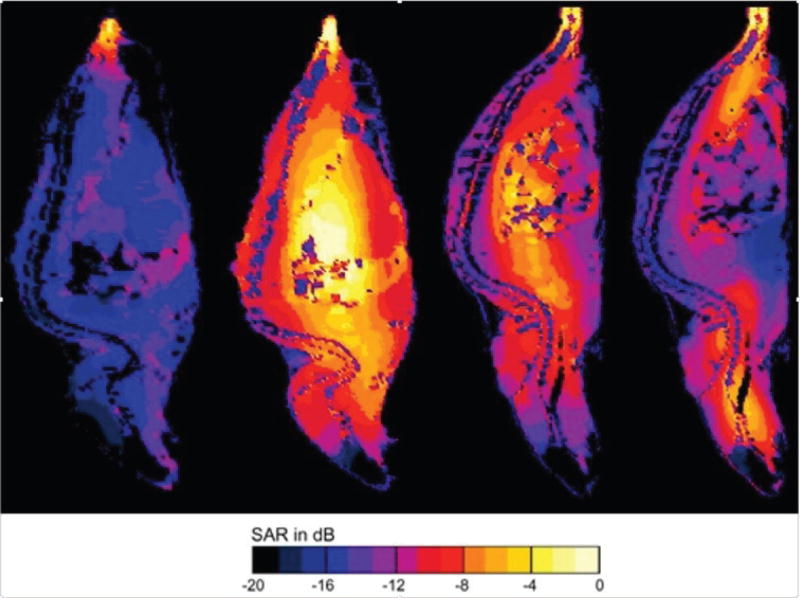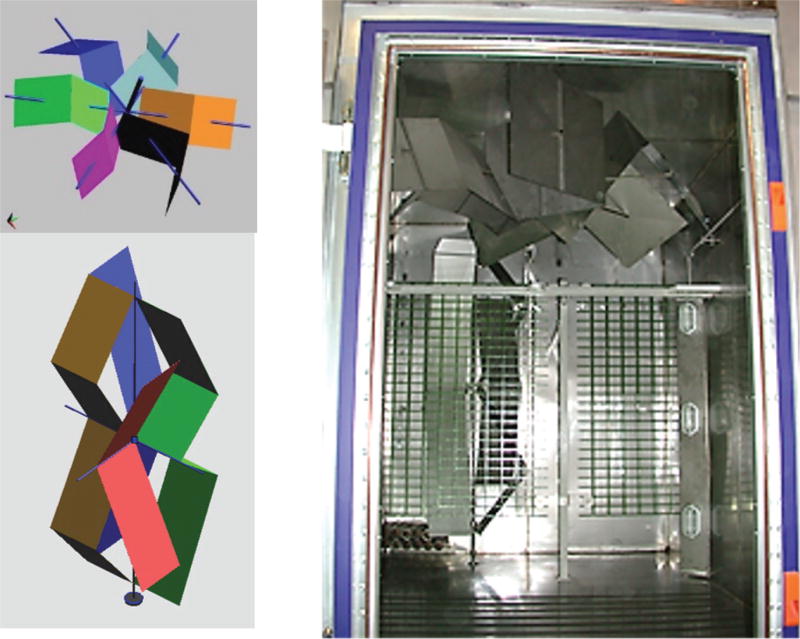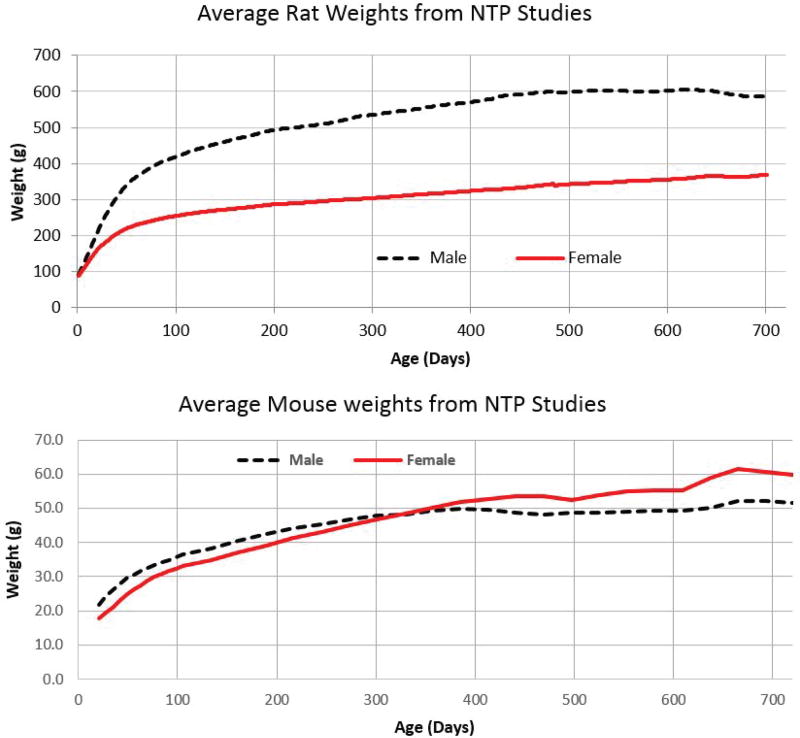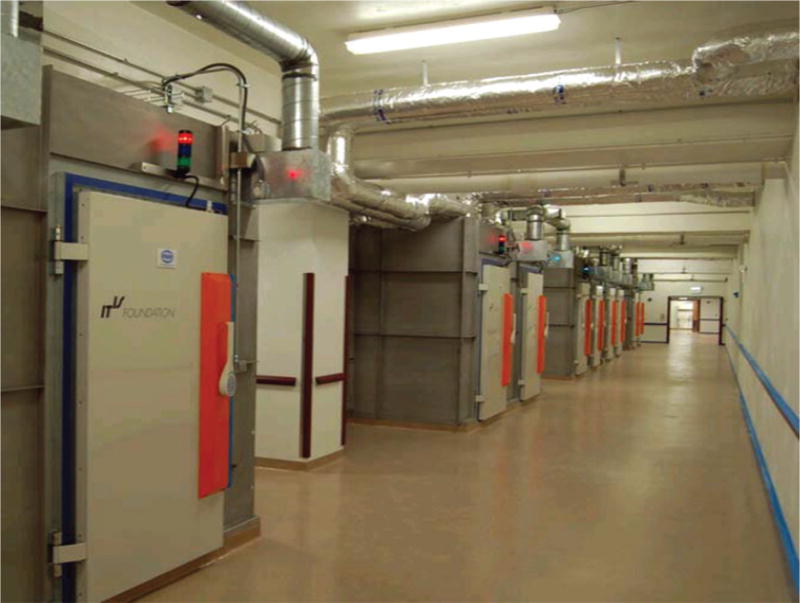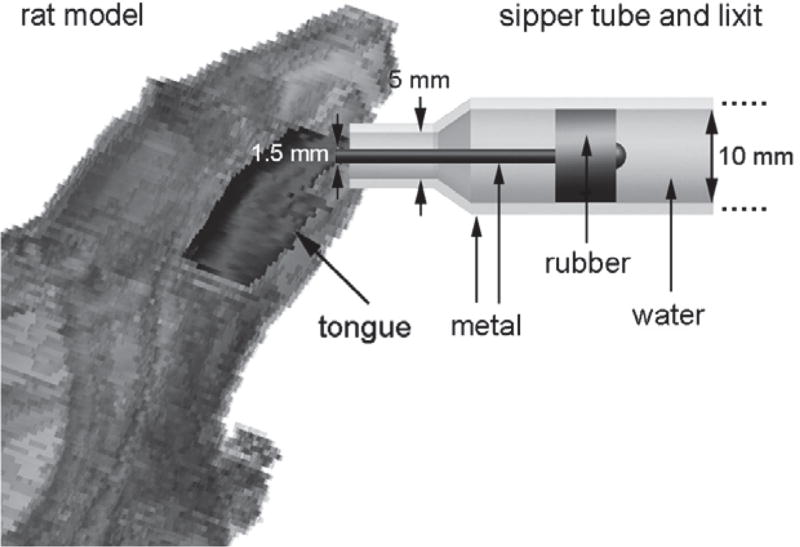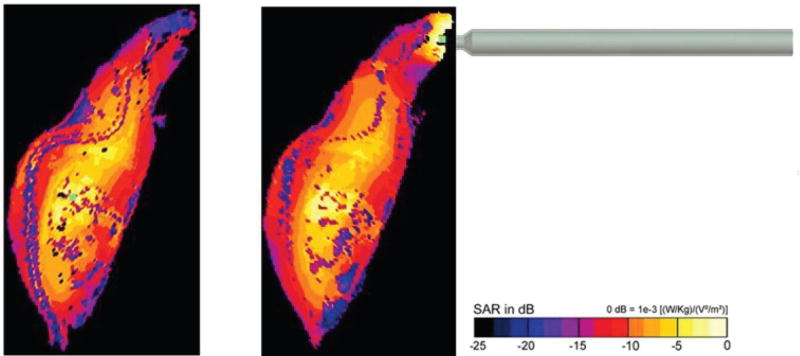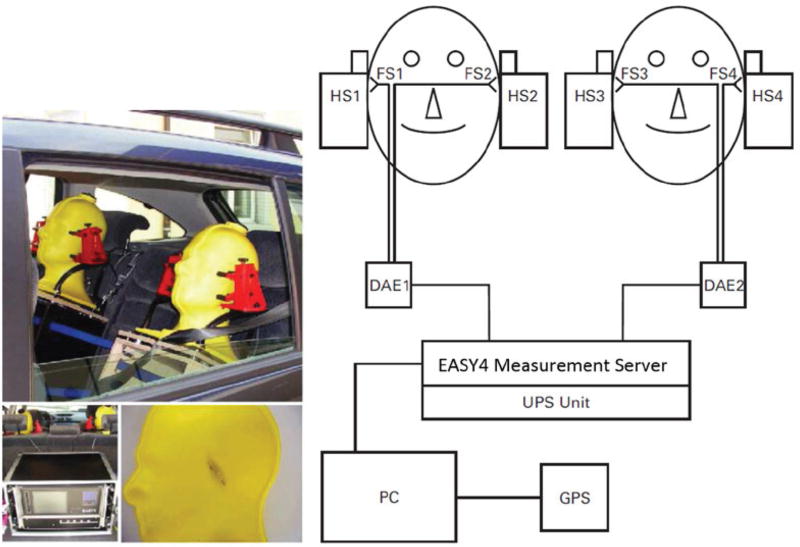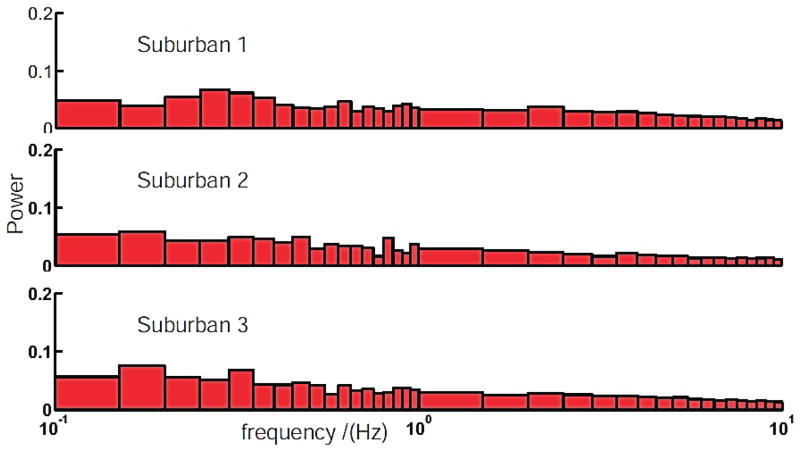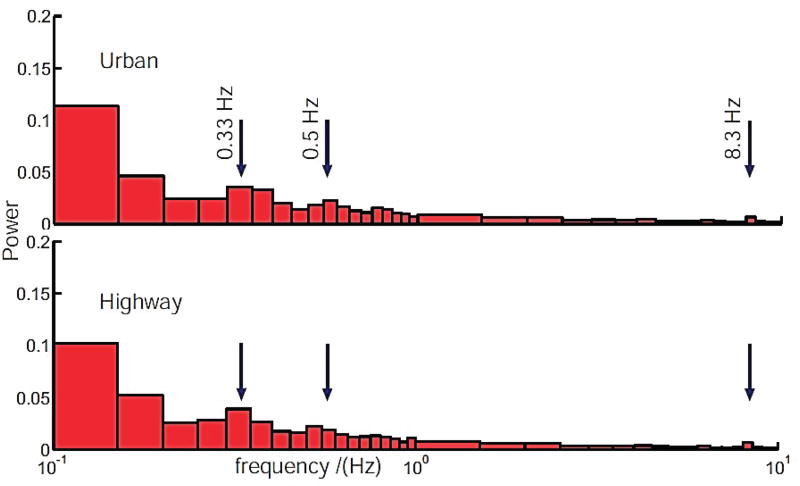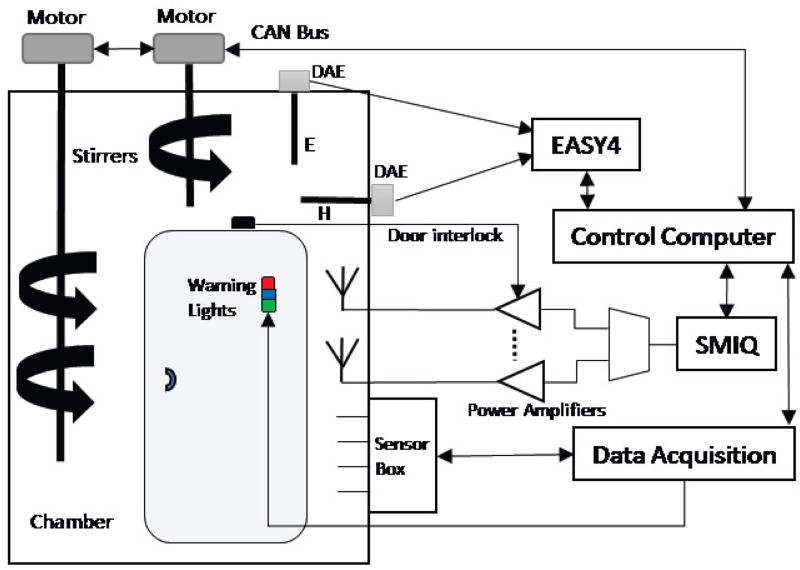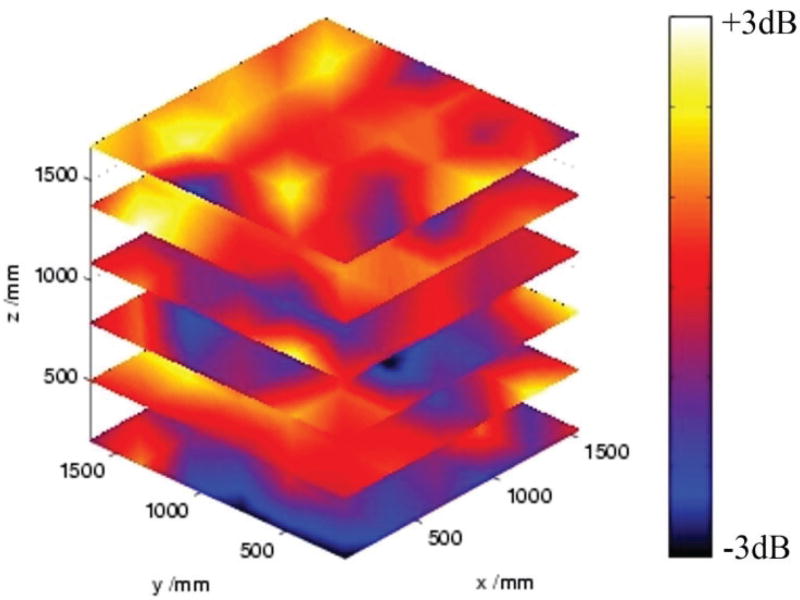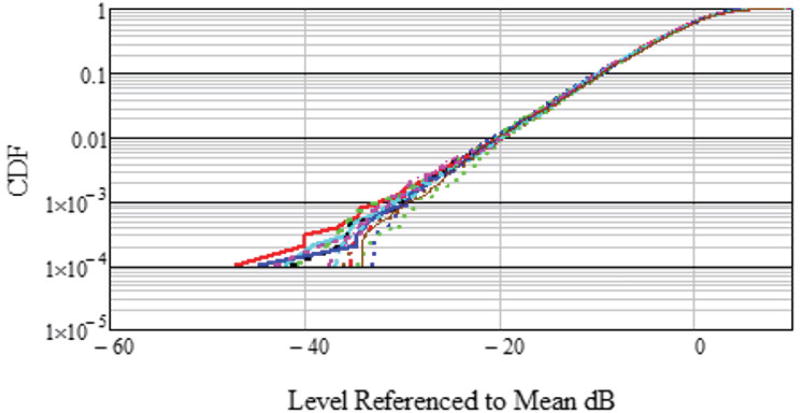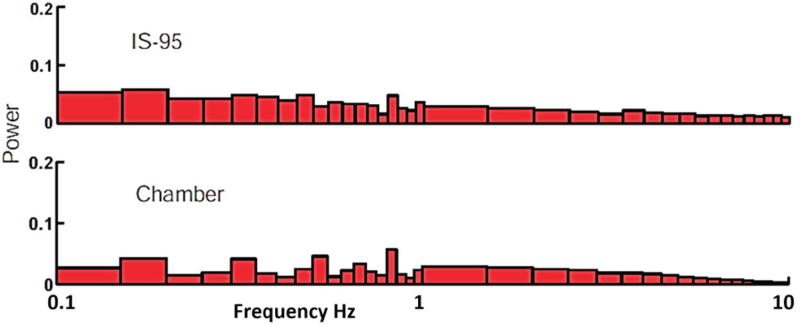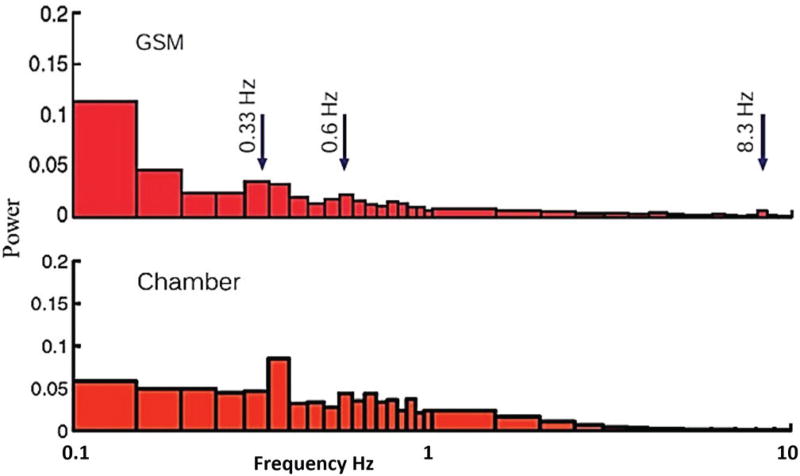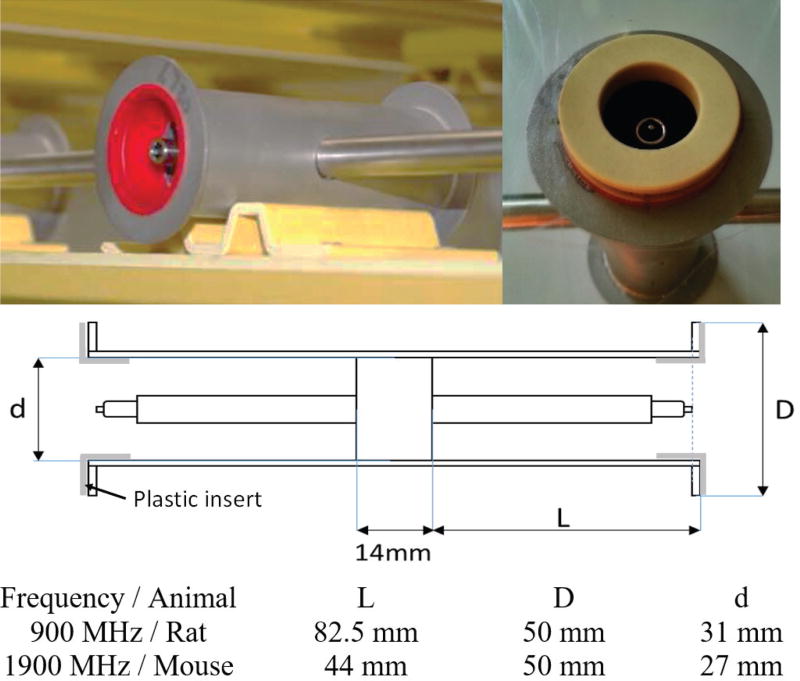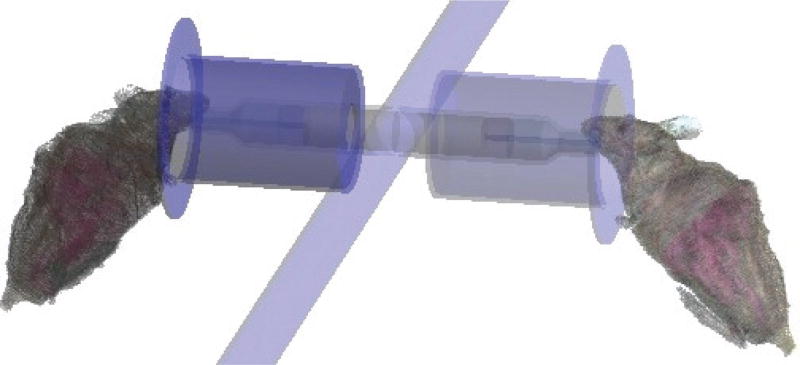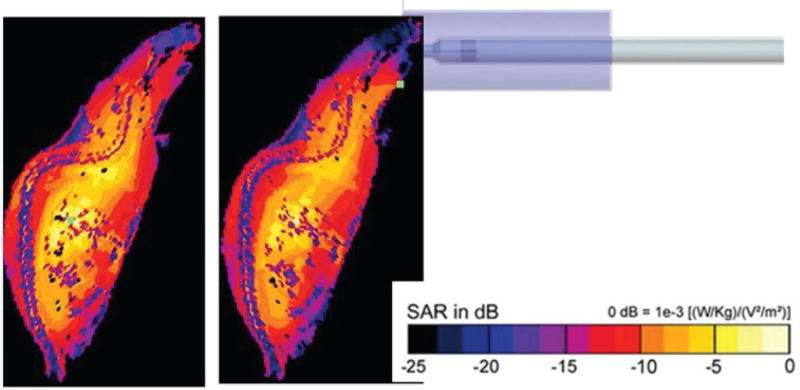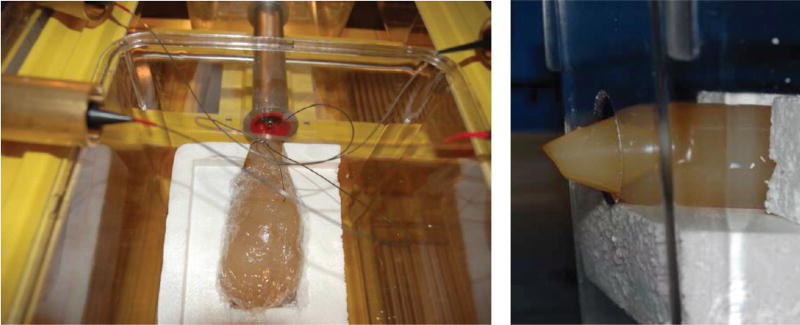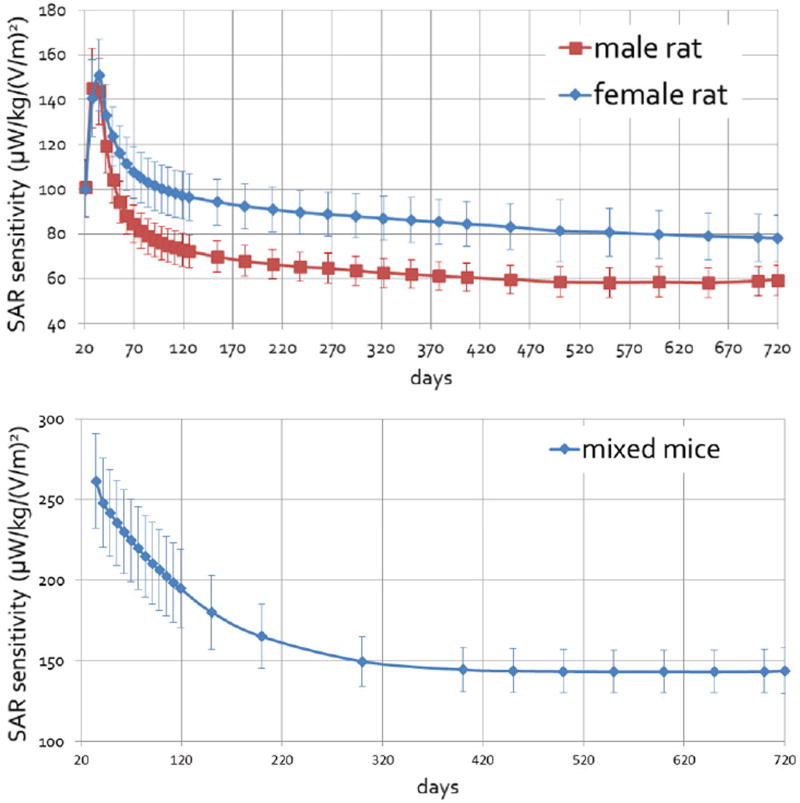Abstract
In this paper we present the novel design features, their technical implementation, and an evaluation of the radio Frequency (RF) exposure systems developed for the National Toxicology Program (NTP) of the National Institute of Environmental Health Sciences (NIEHS) studies on the potential toxicity and carcinogenicity of 2nd and 3rd generation mobile-phone signals. The system requirements for this 2-year NTP cancer bioassay study were the tightly-controlled lifetime exposure of rodents (1568 rats and 1512 mice) to three power levels plus sham simulating typical daily, and higher, exposures of users of GSM and CDMA (IS95) signals. Reverberation chambers and animal housing were designed to allow extended exposure time per day for free-roaming individually-housed animals. The performance of the chamber was characterized in terms of homogeneity, stirred to unstirred energy, efficiency. The achieved homogeneity was 0.59 dB and 0.48 dB at 900 and 1900 MHz respectively. The temporal variation in the electric field strength was optimized to give similar characteristics to that of the power control of a phone in a real network using the two stirrers. Experimental dosimetry was performed to validate the SAR sensitivity and determine the SAR uniformity throughout the exposure volume; SAR uniformities of 0.46 dB and 0.40 dB, respectively, for rats and mice were achieved.
Index Terms: RF exposure, reverberation chambers, dosimetry, Specific Absorption Rate (SAR), National Toxicology Program
I. Introduction
A. Purpose and Scope of the Project
This paper is a summary of the design and performance of a system that enables chronic exposure of large groups of rodents to the radio frequency (RF) electromagnetic fields (EMF) associated with personal mobile phone technologies. The unique feature of this system, as compared to previously employed devices [1]–[6], is that the rodents can be exposed to assess the potential chronic toxicity or carcinogenicity of mobile phone radiation according to the standard protocols of the National Toxicology Program (NTP) [7] of the National Institute of Environmental Health Sciences (NIEHS). The objective of a NTP cancer bioassay is to expose laboratory animals to a chemical, biological, or physical agent for at least 2 years; in this case the physical agent is the RF radiation from personal mobile phones. In addition to the 2-year exposure, the design of the chronic studies required four groups (three dose groups and a sham control group), two species (mice and rats), and a minimum of 100 animals per sex per species per group. To maximize the possibility of detecting toxic or carcinogenic effects, the selection of the highest dose is of key importance. This dose, defined as either the maximum deliverable dose or the maximum tolerable dose, is estimated from prechronic studies and is expected to neither increase mortality from causes other than exposure-related tumor induction nor to cause more than a 10% decrease in body weight gain compared to controls. The NTP test requires also that the exposure level be practically constant over the lifetime of the subjects and that the animals be free to move within the individual cages. Because of concerns that heating effects would limit exposure intensities to levels not much higher than expected from personal mobile phone use and to provide adequate challenge to the hypothesis that RF EMF does not cause tumor induction, the NTP protocol extended the duration of exposure to approximately 18.5 hours/day.
B. Scientific and Technical Requirements
The biological and animal care requirements of NTP chronic tests have immediate impact on the scientific and technical design of exposure systems, including the need to expose at the same dose rate 100 rodents that are free to move in their individual cages. Animal postures presenting different geometries to incoming RF energy would cause different specific absorption rates (SAR) if the fields are incident from only one direction. While drinking, the rodents are in contact with a water column that acts as an antenna to deliver undesired excessive energy to the head of the subjects. Thus, the water delivery system needs special design attention to prevent local overexposure of the animals. Since the rodents must be exposed in individual cages, the cage material must be nearly RF transparent to not appreciably alter the dose imparted to the subjects from incoming RF energy. The exposure of the NTP test must mimic real world signaling (not the exposure level) from a portable cell phone. The signal amplitude changes with time in a complicated statistical fashion that depends on proximity to a base station as well as RF scattering and reflecting, or absorbing objects that the signal from the phone encounters as it propagates to the base station antenna. A system that fulfills all these technical and scientific requirements would indeed expose animals to RF energy similar to that emitted by cell phones with the variations of the signal level caused by fading, as the mobile phone travels in a city environment.
C. Previous Technology and Selected Exposure Systems
No previous exposure systems have ever had to satisfy all the NTP requirements outlined above. In [1], rodents were exposed 5 per cage, making their individual doses extremely difficult to assess. In the present program, all study animals were housed individually to permit an assessment of individual animal exposures. In [2], [3], animals were placed in a carousel with their heads near an antenna to simulate the exposure from a cell phone. In [4]–[6], the whole body exposures of the rodents positioned in a radial waveguide were far from uniform and their positions within the exposure system had to be rotated over time to ensure reasonably equivalent whole body exposures. In [2]–[6], each rodent was constrained in a plastic container to prevent the animal from reversing its head-tail position with respect to the radiating antenna, however, due to animal welfare considerations, exposure durations in restrained animals cannot exceed 4 hours per day. Furthermore, animal restraint may induce stress responses that are undesirable. A more complete review of different in vivo exposure systems can be found in [8]. Exposure of unrestrained study animals in their home cages permits a greater duration of daily exposure than is possible with carousel systems, and removes possible stress resulting from animal restraint. In [9] an unrestrained animal was exposed in a circularly polarized waveguide, however one waveguide would be required for each animal in the study. Hence the use of waveguides, TEM cells, and other metal enclosures comparable in size to a single subject must also be excluded. Isotropic field type solutions such mode stirred resonant cavities or reverberation chambers provide an environment where the posture and orientation of the animals have much less impact on the energy absorption than in the case of single directional fields. Consequently, animals can roam freely within their cages and extended daily exposure periods can be utilized, while the overall exposure efficiency can be maintained at a high level. The idea of using reverberation chambers for animal exposure to EMF as a means of maximizing the total deliverable dose i.e., the exposure time product was first suggested by Ladbury et al. [10]. The operating paradigm is that the field in a reverberation chamber is essentially statistically isotropic.
II. Materials and Method
A. Exposure Frequency
Reverberation chambers were chosen as the exposure environment to provide high efficiency isotropic exposure for unrestrained rodents. However the frequency or frequencies as well as communications system standards to be used for the exposure had to be determined, as these are important for many aspects of the chamber and system design. Dosimetry was performed within a pre-study at communications-system-relevant frequencies commonly in use in the USA. The SAR distributions in the animals needed to be relatively homogeneous, such that a wide range of tissues and organs would have significant exposure, thus maximizing the possibility that RF related effects would be observed, given that the potential origin / site of interaction was unknown. The simplified 12-plane wave model for the average exposure in a reverberation chamber was used within the finite difference time domain (FDTD) solver in SEMCAD X (SPEAG, Switzerland)1 in conjunction with a range of anatomical mouse and rat models (Fig. 1) to determine the SAR in rats and mice at mobile phone frequencies.
Fig. 1.
Anatomical rat model (Pregnant Rat, DOI: 10.13099/VIP91104-01-0) and mouse model (Pregnant Mouse, DOI: 10.13099/VIP91204-01-0) used for numerical dosimetry.
The pre-study provided the results shown in Fig. 2 for, from left to right, a mouse exposed at 900 MHz, a mouse at 1900 MHz, a rat at 900 MHz, and a rat at 1900 MHz. Based on the analysis of the SAR distributions, 900 MHz was chosen for rats and 1900 MHz for mice to meet the homogeneous exposure criteria over the life time and typical weight range. The frequency has an impact on the minimum size of the chambers due to the requirement for the location of the animal to remain greater than three quarters of a wavelength from the walls and for the statistical field homogeneity and isotropy to be minimally influenced by the stirrers and metallic surfaces.
Fig. 2.
SAR distribions from left to right, a mouse exposed at 900 MHz, a mouse at 1900 MHz, a rat at 900 MHz, and a rat at 1900 MHz.(not to scale).
At the beginning of the project, second generation (2G) communications systems were commonplace, and third generation (3G) systems were rolling out. Hence, both 2G and 3G signals were chosen, namely GSM and the code division multiple access (CDMA) scheme IS95, as the communications standards.
B. The Physical-Mechanical Design of the Reverberation Chamber
The reverberation chambers here are resonant enclosures in which the field structure is continuously altered with ‘mode’ stirrers that can provide a statistically homogeneous field distribution when averaged over the time of a stirrer rotation within a specific volume in the chamber [11]. In the NTP studies, animals will be exposed at three SAR levels or sham (no exposure) for up to two years. The use of a range of SAR levels will enable any possible dose response relationship to be elicited. The design of the reverberation chamber had to satisfy the requirements of both the electrical design and animal housing regulations. To comply with NTP guidelines, non-toxic sterilizable materials must be used, and from an electrical point of view, the chamber must be fully shielded. The resultant solution was a fully welded stainless steel design with a standard shielded room door (EM Engineering, Korea)1. Stainless steel is slightly less conductive than normal steel, so there is a slight compromise with the ultimate quality (Q) factors achievable. The tight requirements regarding field homogeneity and the requirement to be able to place animal racks in the chambers necessitated a design with near optimal mode stirrers to minimize the stirrer volume and hence facilitate the optimization of the shape and size of the usable test volume. We used the stirring methods described in [12] that provide designs with no symmetry and large reflecting surfaces for maximum scattering of the fields. Furthermore, two stirrers, with horizontal and vertical orientations, were used. The first stirrer is placed vertically at the rear of the chamber and the second horizontally on the ceiling Fig. 3. The stirrers are driven by a Maxon RE 40 motor with HEDL5540 position encoder driving a 90:1 gear box (Maxon Motor, Sachseln, Switzerland)1. The overall chamber size was chosen such that, with the stirrers in place, the required number of animals could be housed in individual cages while maintaining greater than the minimum distance to the walls and having sufficient volume for efficient mode stirring.
Fig. 3.
Internal view of the reverberation chamber showing the two stirrers.
The NTP chose Harlan Sprague-Dawley rats [13] (Harlan, Indianapolis, IN, USA)1 and B6C3F1 mice [14] (Taconic, Germantown, NY, USA)1 for the study and used a group size of 100 per sex, per species, per group to increase the statistical power to identify weak effects. Mice require much smaller cage floor areas than rats, hence twice as many mice can be housed as rats in a given chamber. Additionally, the growth curves of the male and female animals must be considered. In Fig. 4, we see that male and female rats differ by almost a factor of two in weight after a few weeks of development, whereas male and female mice maintain very similar weights over their whole life spans. Given that the SAR for a given incident exposure E-field is a function of the animals body weight, adequate exposure homogeneity could be attained only by housing male rats and female rats in separate reverberation chambers.
Fig. 4.
Male and female Sprague Dawley rat weights (top), male and female B6C3F1 mouse weights (bottom).
Therefore, to meet the requirements for the NTP chronic studies, a total of 21 reverberation chambers are required to house the animal groups given in Table I.
TABLE I.
Animal Exposure Groups
| 3 power levels for mice (mixed male and female) exposed to 1900 MHz GSM modulated signals |
| 3 power levels for mice (mixed male and female) exposed to 1900 MHz CDMA modulated signals |
| 1 sham chamber for mice (mixed male and female) |
|
|
| 3 power levels for male rats exposed to 900 MHz GSM modulated signals |
| 3 power levels for male rats exposed to 900 MHz CDMA modulated signals |
| 1 sham chamber for male rats |
|
|
| 3 power levels for female rats exposed to 900 MHz GSM modulated signals |
| 3 power levels for female rats exposed to 900 MHz CDMA modulated signals |
| 1 sham chamber female rats |
The exposure group sizes were all set at an initial number of 112 per species and sex. In the case of the male rats, once the animals’ weights were greater than 500 g, the cage size needed to be increased, thus the maximum number of animals was reduced to 102. Based on the stirrer volume and size of the racks to accommodate the required number of cages, the final chamber dimensions were chosen as width w = 2.2 m, length l = 3.7 m, and height h = 2.6 m. The chambers were installed at the IIT Research Institute in Chicago, IL. Some of the installed chambers are shown in Fig. 5.
Fig. 5.
RFR reverberation chambers installed at IITRI.
The RF signals are introduced into each chamber with one or more antennas. Although in a reverberant environment, the effective gain of any antenna is unity (i.e., it appears to be isotropic), the use of directional antennas is advantageous because maximum scattering of the field, and hence statistical homogeneity, can be achieved when the antenna(s) point directly at a stirrer and thus avoid direct illumination of the exposure volume. We used standard gain antennas [15] of relatively simple structure two half-wave dipoles fed in phase a half wave apart and a quarter wave above a square ground plane one wave length on the side. Where high SAR is required, a number of amplifiers might be used, in which case each can be attached to a separate antenna and the chamber is used as a cavity combiner, thus avoiding the requirement for external power combiners and very high power antennas. If the field in the chamber is ideally scattered, then it will vary at any given point with Rayleigh fading statistics [16].
The required E-field strength was determined from numerical dosimetry performed with SEMCAD X (SPEAG, Switzerland)1 with both the plane-wave integral representation of a reverberation chamber [17] and high-resolution animal models based on different size models covering the expected life span [18].
C. Drinking Water System and RF Modulation
Drinking water for rodents in laboratory studies is typically supplied from water bottles or an automatic watering system. For an experiment where close to 3,000 rodents are planned, only an automatic watering system makes practical sense. Water is supplied from a Lixit valve1 [19] placed just outside the rodent cage, that can be reached through a cage grommet, when the mouth touches the Lixit the flow of water is released and the animal can drink. Fig. 6 shows a cross section of a rat drinking from a Lixit. Lixit valves are manufactured from stainless steel and the cage grommet is also typically metallic; these materials are undesirable for an RF experiment. The system to supply drinking water should ensure that no energy is absorbed by the water thereby causing dose-dependent elevation in drinking water temperature that could act as a confounder. Additionally, absorption in the water would decrease the Q of the chamber, decreasing efficiency. Water must therefore be supplied in stainless steel tubes, with the water shielded from the RF fields. Stainless steel tubes and Lixit valves could act as antennas to enhance the E-fields, particularly around the ends of the structures, causing increased SAR or RF burns to the animal whilst drinking. Guy et al [9] overcame this problem for his waveguide system by having a glass sipper tube tip accessed through a small hole in the side of the waveguide, however, the water was housed outside the exposure environment and the tip at the E-field minimum, neither of which are possible within this study.
Fig. 6.
Detail of a rat drinking and the cross section through a Lixit valve.
Fig. 7 shows the potential problem of SAR enhancement in the mouth with high exposures compared to the animal distant from the lixit, in this case a greater than 10-fold increase. Therefore, to facilitate the safe supply of water, a new concept to prevent the high E-field strengths that would be present around the Lixit in a standard watering system had to be developed. Furthermore durable alternatives to metallic cage grommets had to be investigated and used throughout. Gel phantoms were used to experimentally assess the changes in SAR as the mouse or rat approaches and then touches the Lixit. A choked and shielded automatic watering system that was designed for these studies is described under Results.
Fig. 7.
Relative SAR in a rodent not drinking and drinking from a standard Lixit in a high RF field strength environment.
Another important aspect of the chamber design requirements is the mimicking of the temporal variation of the signal as emitted from a mobile phone due to power control. Rayleigh fading due to scattering and reflection of RF signals within the propagation environment is observed by the base station receiver, as the mobile phone moves, for example, within urban or highway environments. The system acts to counter this received signal variation by controlling the transmitted power of the mobile phone, resulting in temporal emitted power variation.
The design of the stirrers can be such that the spatial variations in the average field strength can be minimized, or at least controlled within specified bounds. This will be shown in the next section. In addition, the temporal variations introduced by the rotation of the stirrers can be tailored to provide a change in exposure that has meaningful correlation to real world exposure variations [20]. We record the the power level vs. time – hence the actual exposure of real mobile phones when operated in different propagation environments and performed a Fourier transform to determine the low-frequency components of the power variation. Fig. 8 shows the measurement setup; in Fig. 9, the low frequency spectral components for a typical IS95 mobile phone power level are plotted. Fig. 10 is a plot of the low frequency spectral components for a typical GSM mobile phone power level [21]. The rotation velocities of the two stirrers can be tuned to provide a variation that mimics many key characteristics of the real signal variation. Individual components can be created by a combination of the beat frequency of the stirrers and the absolute rotational speed. The velocity of rotation and the relative differences depend on the mobile communication system to be mimicked, as they have different power-control characteristics. The mode density in the chamber at a given frequency also impacts the required angular displacement to achieve a given field-strength variation at a single point in the chamber.
Fig. 8.
Mobile system to record the temporal variations of mobile phone power level, for details see [21].
Fig. 9.
Relative level of the spectral components of an IS95 mobile phone output power due to power control urban and highway environments.
Fig. 10.
Relative level of the spectral components of a GSM mobile phone output power due to power control in urban and highway environments.
D. Computer Control of RF Exposure and Chamber Environment Monitoring
The control system manages the exposure schedule, stirrer rotation speeds, and exposure signal type and level in each chamber. It also monitors air flow, temperature, humidity, oxygen level, light level, and E/H-field in the chambers. The schematic design is shown in Fig. 11.
Fig. 11.
Block diagram of the exposure and control system.
The signal source is a SMIQ02B signal generator (Rohde and Schwarz, Germany)1, with options for GSM and IS95 modulation. The configuration of the GSM uplink signal is generally based on technical standards for mobile communication at GSM900 of the European Telecommunication Standard Institute1 (ETSI) with one slot per frame active in any given GSM chamber, and the standard uplink signal generator settings for IS95 are utilized. Modulation characteristic settings can be seen in Table II.
TABLE II.
IS95 and GSM Modulation Characteristics.
| Quantity | IS95 | GSM |
|---|---|---|
| Modulation: | QPSK | GMSK |
| Chip rate: | 1.22880Mcps | n/a |
| Rev link filter | IS95 | Gaussian |
| Roll-off factor | 0.2 | 0.5 |
| Uplink channel type | traffic | traffic |
| Channel rate | 9600bps | 270,833symbols/s |
| Frame quality indicator | on | n/a |
| Convolutional encoder | on | n/a |
| Block interleaver | on | n/a |
| Peak-to-average ratio | 5.39dB | 9.1dB |
To amplify the signals, we used 400 W peak power or 200 W average power amplifiers (LSE, Spanga, Sweden)1,12 in the rat system, 6 in the mouse system and distributed so that the SARs can be maintained at the defined whole body SAR (wbSAR) levels of the given chamber. The output of the power amplifier is then directed to either GSM or IS95 chambers with a high isolation RF relay. A fast switch allocates GSM slots to different chambers to allow the same amplifier to be used with four different chambers. The control system prevents the relay or switch from switching while RF power is present, ensuring that the PIN diodes or relay contacts are not damaged during switching. A number of dedicated real time controllers set the individual amplifier output powers on a slot by slot basis for GSM and for IS95 to afford uncoupled control of the E-field strength in each chamber. Each chamber has as many standard gain antennas (two half-wave dipoles mounted λ/4 in front of a reflector plate λ2 in size [15]) inside, fed via isolators to limit the reflected power, as the number of amplifiers needed to excite the reverberant cavity. Chambers with more than one antenna are used as cavity combiners, eliminating the requirement for a coaxial combiner. The antennas are directed towards one of the stirrers to ensure the best energy stirring and a good ratio of stirred to unstirred energy, resulting in acceptable E-field homogeneity. The exposure conditions are monitored with two ER3DV6 E-field probes (SPEAG, Switzerland)1 for high peak field strength chambers or one ER3DV6 and an H3DV6 H-field probe (SPEAG, Switzerland)1 for lower field strength chambers. Probes are placed close to the exposure region, with each probe attached to DAE4NIEHS data acquisition electronics which are in turn connected to an EASY4 measurement server (SPEAG, Switzerland)1. Each probe and DAE has its own calibration file. The measured E and H field strengths are used to maintain the exposures to the desired levels through a feedback control algorithm. The data from the probes communicate the field strengths to the control computer. The field strength at any point in the chamber changes temporally at a rate related to the stirrer speeds. The data were sampled with a frequency of 100 Hz, and the E and H-field display was updated every 20 seconds. Though the purpose of the exposure system is to provide a controlled EM field exposure, other environmental parameters are also of key importance to evaluate, as environmental stress factors can act as confounders in any toxicology and carcinogenicity experiment. Hence, the following were monitored and recorded throughout the entire duration of the experiment: oxygen level, temperature, humidity, air flow, noise, and light level. The sensors are integrated into a sensor box located in the air outlet from the chamber, the outputs from the sensors were measured with a number of Agilent 34970A data acquisition units with HP 34901A 20 channel multiplexers (Agilent, Santa Rosa CA, USA)1. The system is required to be RF safe for people working in the facility. Some chambers are supplied with up to 3.8 kW of peak RF power, resulting in high field strengths, thus, the entry of personnel while the exposure system is active must be prevented. Warning lights are provided on each chamber, with a red light to indicate that an exposure is active in that chamber and that the door should not be opened; however, when the door is opened, an interlock immediately disables all amplifiers within that exposure system, thereby placing the system into a safe state. Panic buttons are also placed within the facility such that the power amplifiers can be switched off in case of any emergency.
III. Results
A. Homogeneity of RF Fields in the Target Volume
The important performance metrics for a reverberation chamber used for animal exposures are: 1. E-field homogeneity, 2. E-field isotropy, 3. SAR uniformity, and 4. SAR efficiency. All these characteristics have been separately tested and verified.
The homogeneity of the E-field as measured using 6 ER3DV6 E-field probes (SPEAG, Switzerland)1 providing x, y, and z components as well as vector sum, supported by a non-conductive measurement structure moved around in the empty chamber. Measurements were taken on a 300 mm 3D grid, 216 points in total, the homogeneity (one standard deviation of vector sum averaged over 80 stirrer positions) was 0.6 dB, and the field isotropy (standard deviation of x, y, and z components) was 0.85 dB at 900 MHz; field homogeneity and field isotropy were 0.48 dB and 0.70 dB, respectively, at 1900 MHz. The field magnitude distribution at 900 MHz can be seen in Fig. 12 and the statistics of the fields in Table III.
Fig. 12.
E-Field homogeneity in an empty chamber at 900 MHz.
TABLE III.
E-Field homogeneity and isotropy measured for an empty chamber
| Frequency | 900 MHz | 1900 MHz | ||
|---|---|---|---|---|
|
| ||||
| E-Field Component\ Quantity |
Average Mean Squared (dB) |
Standard Deviation (dB) |
Average Mean Squared (dB) |
Standard Deviation (dB) |
| Ex | −4.7 | 0.89 | −4.9 | 0.65 |
| Ey | −4.9 | 0.77 | −4.8 | 0.63 |
| Ez | −4.9 | 0.84 | −4.7 | 0.8 |
| E-total | 0 | 0.59 | 0 | 0.48 |
| Ex, Ey, Ez | −4.8 | 0.84 | −4.8 | 0.7 |
In a chamber loaded with rat or mouse phantoms, 32 measurement locations were analyzed; these corresponded to 4 locations that, a) could be easily accessed and b) were not too close to the individual phantoms, namely, on the cage tops of each shelf. At 900 MHz, the standard deviation or field homogeneity of the field totals was 0.74 dB and of all three orthogonal field components was 1.1 dB; all components measured at all locations fall within the mean ±2.8dB and all total fields fall within the mean ±1.6 dB. At 1900 MHz, the standard deviation or field homogeneity of the field totals was 0.7 dB and of all three orthogonal field components was 1.3 dB; all components measured at all locations fall within the mean ±3.1dB and all total fields fall within the mean ±2.0 dB.
The ratio of stirred to unstirred energy or the Rician K-factor in the empty chamber give a good indication of the stirring efficiency: the ratio of stirred to unstirred energy at 900 MHz was 18.7 dB and for 1900 MHz was 26.5 dB with Rician K-factor 0.014 and 0.003, respectively.
The measurement of homogeneity has associated uncertainties, some of which are associated with the probes and others with the measurement process. Table V gives the contributions to the uncertainty: aside from the last item, all are associated with the design, manufacture, and calibration of the E-field probes. If the same probe were used to measure all points, the first two sources would become unimportant. Six different probes were used, so that inter-probe variation in accuracy and linearity is important. The largest contribution arises due to limitations in the characterization process, termed stirrer modulation, which has two components. The first is related to the repeatability of a measurement at a given location, and the second is due to the number of discrete stirrer positions used (directly related to the time to measure at each point). Repeating the measurement of E-field strength at a given point gave a 0.2 dB standard deviation in the value obtained when a large number of stirrer positions were used, this uncertainty can be due to stirrer position variations, RF input power variations, and measurement equipment variations. The measured rms E-field strength tends towards a constant value when the number of discrete stirrer points approaches 3500. The step and measure process is relatively lengthy for the stirrer positions to stabilize; hence, to measure many points, the number of positions must be limited. Here, we used 80 points, which result in an additional uncertainty of ~0.4 dB. Therefore, the overall uncertainty is 0.45 dB.
TABLE V.
Exposure Field Uncertainty
| Equipment | Uncertainty | Distr. | Div. | Std. Unc. | |
|---|---|---|---|---|---|
| E & H field probe absolute accuracy | 0.26dB | Normal | 1 | 0.26dB | |
| Frequency linearity | 0.2dB | Rect. |
|
0.12dB | |
| Dynamic range linearity | 0.2dB | Rec. |
|
0.12dB | |
| Isotropy | 0.4dB | Rect. |
|
0.12dB | |
| Homogeneity / 2 probes | 0.43dB | Normal | 1 | 0.43dB | |
| Field control | 0.2dB | Normal | 1 | 0.2dB | |
| Combined Standard Uncertainty | 0.59dB | ||||
The exposure E-field values in all of the 21 chambers and the homogeneity within the most heavily loaded chamber were verified in separate studies performed by NIST [22]. All of the field measurements agreed within the estimated uncertainty bounds, apart from the case of two H-field probes in the highest peak H-field chambers; these probes were subsequently replaced by E-field probes that did not suffer the same high-field strength anomaly. The magnitude of field variation throughout the volume of a fully-loaded chamber was also found to be consistent with the values reported above that were measured in the prototype chamber. The quality of the modulated signals was found to be acceptable with regard to distortion and harmonic content and the power delivery system appeared to be functioning well with only minimal leakage in the switching system.
Fig. 13 shows that, for any level of chamber loading, Q is >260 to <3000, the instantaneous field amplitudes follow a Rayleigh fading statistical distribution [16], as required for field isotropy; therefore, the field statistics will not change as the animals grow throughout the study. The Rayleigh distribution holds for a 30 dB amplitude range, more than sufficient for the purpose of this experiment. The signal statistical functions vs. chamber loading break down at very low field strengths, because the levels are too infrequent for reliable statistical estimation. Fig. 14 and Fig. 15 show the low frequency spectral components due to the power control level of IS95 and GSM mobile phones respectively, and the power variation synthesized in the exposure chambers when the stirrer speeds were optimized. The relative stirrer speeds for IS95 were 4:5 and for GSM, 1:2, the absolute speed depending on the mode density (size and frequency).
Fig. 13.
Normalized cumulative distribution functions (CDF) field amplitude statistics as a function of chamber load.
Fig. 14.
Relative level of the spectral components of an IS95 mobile phone output power due to power control and components generated in the chamber due to the mode stirrer rotation.
Fig. 15.
Relative level of the spectral components of a GSM mobile phone output power due to power control and components generated in the chamber due to mode stirrer rotation.
B. SAR Uniformity in the Target Volume
The SAR uniformity was measured in the same chamber with rat and mouse phantoms consisting of bottles of tissue simulating liquid optimized to provide the same absorption as an adult rodent. The parameters for the rat phantoms were εr = 41.1 and σ = 0.95 S/m and for the mouse phantoms εr = 39.5 and σ = 1.43 S/m corresponding to HSL900 and HSL1900 tissue simulating liquids (SPEAG, Zurich, Switzerland)1. The experimental dosimetry was performed with the final temperature method [23], and showed that the SAR uniformity between animals was ±0.46 dB and ±0.40 dB, respectively, for rats and mice. The phantom SAR values show better uniformity than that of the field measurements due to the spatial averaging over the volume of the animal phantom. The design of any exposure system needs to take into consideration the amount of power that must be generated to achieve the desired animal SAR exposure. One key metric is the overall efficiency in coupling the power transmitted into the chamber and into the phantoms or animals. In loaded reverberation chambers, efficiencies were ~70% for adult rats and ~45% for adult mice.
C. Field Control
Uncertainty in the average E-field strength within the exposure volume with respect to the target value is a function of several factors associated with field measurement accuracy, and the chamber homogeneity, and the control algorithm. The probe design, manufacture, and calibration account for the first four quantities. The chamber field is not perfectly homogeneous, and only two probes are employed to estimate the field strength. This feature reduces the uncertainty due to homogeneity by the square root of the number of probes, but is still an important factor in the overall uncertainty in the average exposure field. That the field varies temporally reduces the accuracy to which the field can be controlled. The field control is estimated from measurements to add 0.2 dB to the overall uncertainty as shown in Table IV.
TABLE IV.
Uncertainty Budget for the Field Homogeneity Measurements
| Equipment | Uncertainty | Distribution | Div. | Std. Unc. | |
|---|---|---|---|---|---|
| E & H field probe absolute accuracy | 0.26dB | Normal | 1 | 0.26dB | |
| Frequency linearity | 0.2dB | Rect. |
|
0.12dB | |
| Dynamic range linearity | 0.2dB | Rect. |
|
0.12dB | |
| Isotropy | 0.4dB | Rect. |
|
0.12dB | |
| Stirrer modulation | 0.45dB | Normal | 1 | 0.45dB | |
|
| |||||
| Combined Standard Uncertainty | 0.58dB | ||||
D. SAR Uniformity in Drinking Subjects
The water system was developed for installation in the chambers without introduction of additional loss by RF absorption in the water by virtue of its fully shielded design. The design can also be used in a reverberation chamber environment with high average E-fields (up to 400 V/m), because it avoids or minimizes: 1) high local SAR peaks in the animal while drinking, 2) variations in whole-body average SAR with respect to the animal not drinking, and 3) significant distortions in the fields around the water system. To this end, a choked and shielded automatic watering system was designed. A simple choke on its own is insufficient; though it is designed to prevent RF current from flowing, it does not protect against high E-field strengths. Therefore, the choke must be extended beyond the end of the Lixit to effectively shield it from the E-fields and prevent E-field enhancement. The resultant design, a coaxial quarter wave choke, is shown in Fig. 16. However, the circumference of the choke has an enhanced E-field to which the drinking rodent could be subjected in relatively close proximity, enhancing the SAR. Therefore, the choke was flanged to both remove the high field region from the Lixit and reduce the field intensity by virtue of the increased circumference.
Fig. 16.
RF quarter wave choke shielding the rodents watering mouthpiece and cage grommet and the dimensions used for the two frequencies.
The numerical simulation model of two mice in drinking position is given in Fig. 17, where the relative position of the face of the animals with respect to the end-flanged quarter wave choke is clearly shown.
Fig. 17.
Choked and flared drinking mouthpieces for the mice.
Numerical analysis was performed with SEMCAD X on the high-resolution anatomical models. An experimental verification was performed with gel animal phantoms and temperature probes in the body head and mouth, also to demonstrate that the designed water system provides a safe drinking environment without disturbing the field homogeneity and isotropy within the animal enclosures. Fig. 18 shows the SAR experienced in the animal with the RF-safe design; we see that the excess SAR in the mouth, shown in Fig. 7, can be completely avoided.
Fig. 18.
SAR in the mouth of a rat when not drinking (left) and when drinking (right) with the special shielded choke design.
Note the very similar SAR distributions in the rodent placed far away from the water system and in the rodent drinking from the flanged watering system. To verify the relative SAR as rats and mice approach the drinking system, tissue simulating gel was used to make rat phantoms into which temperature sensors (T1V3Lab SPEAG, Switzerland)1 could be implanted, three spaced in the nose and head at increasing distance from the contact point to the Lixit and one in the center of the body. The initial slope of the temperature rise was then assessed over an integral number of stirrer rotations, in this case 60 seconds, from reference positions 100 mm and 10 mm from the water system and touching the water system. Fig. 19 shows the gel phantoms with the temperature probes and Table VI shows the initial slope of the temperature rise, which is directly proportional to the SAR. The results confirm that there is little influence of the presence of the RF safe water system on the exposure of the animals as they approach the system and that, in general, the animal becomes less exposed in the mouth and head region while drinking. The variation that is observed is likely related to field homogeneity in the chamber.
Fig. 19.
Tissue simulating gel rat (left) and mouse (right) with implanted temperature sensors.
TABLE VI.
Rates of Change of Temperature in Body and Mouth Regions
| Distance from Lixit |
Rat (mK/s) | Mouse (mK/s) | ||||||
|---|---|---|---|---|---|---|---|---|
|
| ||||||||
| mouth | nose | head | body | mouth | nose | head | body | |
| 100mm | 7.8 | 7.7 | 7.3 | 20.5 | 9.6 | 9.3 | 5.8 | 17 |
| 10mm | 8.8 | 9.4 | 8.4 | 19.5 | 10.7 | 11 | 8.1 | 17.2 |
| Touching | 0.7* | 3.1 | 4.2 | 20.1 | 8 | 7.3 | 4.3 | 17.9 |
possibly very low due to thermal contact with metal of the Lixit
E. Whole body SAR Sensitivity in Aging Rats at 900 MHz and Mice at 1900 MHz
A detailed dosimetric analysis for the rat and mouse models exposed to Rayleigh fading RF energy was performed to establish the proper dose rate throughout the chronic exposure of the rodents. The analytical methodology is presented in detail in a companion paper [18]. The results are summarized here to indicate how the exposure system power output, needs to be adjusted to impart to the rodents approximately the same dose rate for different average body weights during aging and for different postures. Among all the models, the uniformity of whole-body averaged SAR (wbSAR) has the maximum standard deviation of 2.9 dB at 900 MHz for small female rats and 2.6 dB for small male mice at 1900 MHz. The spatial-peak SAR averaged, has the average difference from wbSAR of 10.5 dB at 900 MHz for female rats, and 9.1 dB for male mice at 1900 MHz. Regarding organ-specific averaged SAR results, deviations to the wbSAR were calculated and compared for all rat and mouse models. Among all the organs, the SAR deviation can differ as much as −9 to +5 dB from the wbSAR for rats at 900 MHz, and −8 to +4 dB for mice at 1900 MHz. In addition to detailed analysis of the SAR uncertainty of rodents, the instantaneous variation due to rodent posture, size, and weight variation with a given exposure group has been performed as shown in Fig. 20 [18].
Fig. 20.
Lifetime dependent wbSAR sensitivity based on days with instantaneous variation.
IV. Conclusion
In this paper, we have presented the design criteria and test results for a room-size exposure chamber capable of housing a large number of rodents for an NTP assessment of the toxicity and carcinogenicity of RF signals emitted from widely used cell phones; 21 such chambers were installed at the test site. The NTP tests, require uniform dose delivery that, for RF energy, could be satisfied only by a uniform (over the entire 4π solid angle) distribution of field directions to the test subjects. This has been accomplished by means of reverberation chambers. For the first time, the modulation due to the periodic rotational motion of the stirrers has been chosen to simulate the low frequency variation of a phone’s RF output power, due to power control, as the phone user moves. The daily long-term exposure of rodents required a water supply system that did not heat the water, significantly alter the field distribution, and did not overexpose the tests subjects while drinking. This goal was accomplished by means of shielded water distribution pipes and choked, flanged drinking Lixits. The RF power radiated into the chambers follows the required signal level changes to keep the wbSAR dose constant as the rodents grow and age using the actual weight of the animals in the study. The highest dose groups are facilitated by the use of the reverberation chambers as cavity power combiners. The overall efficiency (power absorbed in the animals / input power to the chamber) for adult mice and rats was very high at 45% and 70% respectively. The other physical and environmental parameters are monitored and recorded. As a summary, the expanded uncertainty (k = 2) of the exposure level is around 1.7 dB for the rat and mouse exposure, and around 1 dB between different dose groups. The life-time averaged standard variation of the individual in the exposure group is 0.2 dB for the rat and 0.3 dB for the mouse. An extensive dosimetric research effort, detailed in a companion paper [18], documents the dose rate distribution in the body of rats and mice undergoing chronic RF exposure in the chambers presented in this paper. We conclude that the design and construction of the chambers satisfy the NTP RF test requirements for a large number of unconstrained rodents simultaneously exposed.
Acknowledgments
Work partially supported by the United States government, not protected by United States copyright.
This work was funded by Contract No. HHSN 29120055544 (ADB No. N01-ES-55544) from the National Toxicology Program, National Institute of Environmental Health Sciences, NIH.
Biographies
Myles H. Capstick received his B.Sc. and Ph.D. degrees from the University of Wales in Bangor in 1987 and 1991, respectively. He was appointed as a lecturer in the School of Electronic Engineering Science at the University of Wales, Bangor in 1990. He moved to The University of York, Department of Electronics in 1996, where he was first a lecturer and latterly a senior lecturer. In May of 2006 Myles joined the ITIS Foundation in Zurich, Switzerland. His expertise is across a wide range of areas encompassing RF, microwave and mm-wave systems, circuits, antennas and measurements, communications systems, EMC and dosimetry. Myles research interests are in electronic engineering science for biomedical and health risk assessment applications. He has experience of the design and manufacture of RF equipment for use in dosimetry and in particular the equipment used in all the human volunteer trials within the Mobile Telecommunications and Health Research Programme of the UK Department of Health as well as studies using human phantoms. For in-vitro and in-vivo research he has designed systems including: reverberation chamber systems, resonant TEM line systems, systems for live imaging of cells during exposure to both ELF and RF. Within the medical research field, RF hyperthermia and magnetic nano-particle hyperthermia equipment, MRI RF and gradient field exposure test systems for medical implant safety assessment are areas of activity. He has also worked on health risk and occupational exposure assessment of body worn antennas, wireless power transfer devices and MRI. Furthermore, he has developed new measurement instrumentation for improved assessment of safety in EM fields and for measurement of miniature body worn devices.
Niels Kuster received the M.S. and Ph.D. degrees in electrical engineering from the Swiss Federal Institute of Technology, ETH Zurich (ETHZ), Zurich, Switzerland. From 1993 to 1999, he was an Assistant Professor with the Department of Electrical Engineering, ETHZ. In 2001, he became a Professor with the Department of Information Technology and Electrical Engineering, ETHZ. Since 1999, he has been the Founding Director of the Foundation for Research on Information Technologies in Society (ITIS), Zrich, Switzerland. In 2010, he initiated the sister institute ITIS USA, a nonprofit research unit incorporated in the State of Maryland, of which he is currently the President. During his career, he has been an Invited Professor with the Electromagnetics Laboratory of Motorola Inc., Fort Lauderdale, FL, and, in 1998, with the Metropolitan University, Tokyo, Japan. He also founded several spin-off companies: Schmid and Partner Engineering AG, MaxWave AG, NFT Holding AG, and Zurich MedTech AG and advises other companies as a board member. He has authored or coauthored over 200 publications (books, journals, and patents) on measurement techniques, computational electromagnetics, computational life sciences, dosimetry and exposure assessments, and bioexperiments. His primary research interests are in EM technologies, in silico tissue models and personalized medicine. Dr. Kuster is a member of several standardization bodies and serves as a consultant on the safety of mobile communications for government agencies around the globe. He is a Fellow of the IEEE Society, a delegate of the Swiss Academy of Science, a senior member of the IEICE and an associate editor of IEEE Transactions on Electromagnetic Compatibility. He served as the President of the Biolectromagnetics Society from 2008–2009 and as board member of various societies. In 2012, he received the prestigious d’Arsonval Award, the highest scientific honor of the Bioelectromagnetics Society.
Sven Kühn received his Dipl. Ing. (MSc) in Information and Communication Technologies from Chemnitz University of Technology, Germany in 2004. At the end of 2004, he joined the Foundation for Research on Information Technologies in Society (ITIS), Switzerland, where he started to work on numerical and experimental methods for the assessment of human exposure to electromagnetic fields. In 2005, he also joined the Integrated Systems Laboratory (IIS) at the ETH Zurich to start working towards his Ph.D. in Electrical Engineering. In August 2009, Sven joined Schmid and Partner Engineering, where he heads sensor design, pursuing Research and Development work towards a new product generation of miniature electro-optical sensors. He also leads the development of the DASY NEO product and EMC analysis tools. In September 2009, Sven completed his Ph.D. at the Swiss Federal Institute of Technogy (ETH Zurich) and was awarded the Medal of the ETH Zrich and the Prize of the Hans Eggenberger Foundation. Sven became a co-founder of Zurich MedTech (ZMT) in 2006. His main research interests include experimental and numerical dosimetry in bioelectromagnetics, classical electromagnetic compatibility, near-field sensor, radio-frequency circuit, and antenna design, and optics as well as bio-medical applications thereof. Sven is the author or co-author of numerous journal and conference papers as well as book chapters and serves as a scientific reviewer for various journals.
Veronica Berdinas-Torres received the M.S. degree in Physics from University of Santiago de Compostela, Spain. In 2002, she joined the Foundation for Research on Information Technologies in Society (ITIS), Switzerland, where she worked on electromagnetic exposure systems analysis and dosimetry assessment. In 2004 she also joined the Integrated Systems Laboratory (IIS) at the Swiss Federal Institute of Technology (ETH Zurich) to start working towards her Ph.D in Electrical Engineering, which was completed in 2007. From 2007 to 2012, Veronica Berdinas worked as project leader at the Swiss Federal Institute for Material Science in Dbendorf, Switzerland, in the field of Electronics, Metrology and Reliability. In 2012, she joined ABB Switzerland as a senior engineer developing bushings for high voltage transformers. Since 2015, Veronica works at Siemens Mobility Switzerland developing special safety functions for electronic interlockings.
Yijian Gong received her M.S. and Ph.D degrees in Technical University Munich, Munich, Germany and Swiss Federal Institute of Technology, ETH Zurich (ETHZ), Zurich, Switzerland, in 2008 and 2016, respectively. From 2009 to 2015, she worked in the ITIS Foundation, Zurich, Switzerland. Her research interest is in bioelectromagnetics, electromagnetic exposure safety analysis, dosimetry assessment within in vitro and in vivo studies.
Perry F. Wilson (S78M82SM93F05) received the Ph.D. degree in electrical engineering from the University of Colorado, Boulder, CO, USA, in 1983. He currently leads the RF Fields Group in the RF Technology Division of the National Institute of Standards and Technology, Boulder, CO. His research has focused on the application of electromagnetic theory to problems in electromagnetic compatibility and RF field metrology. Dr. Wilson is a member of US IEC TC77B TAG, past Editor-in-Chief of the IEEE EMC Transactions, a recipient of a 2010 IEEE EMC Society Technical Achievement Award, a recipient of the 2002 IEEE EMC Transactions Best Paper Award, and a recipient of a 2007 US Department of Commerce Gold Medal.
John M. Ladbury was born in Denver, CO, in 1965. He received the B.S.E.E. and M.S.E.E. degrees (specializing in signal processing) from the University of Colorado, Boulder, in 1987 and 1992, respectively. Since 1987, he has been involved in Electromagnetic Compatibility (EMC) metrology and facilities at Radio Frequency Technology Division, National Institute of Standards and Technology, Boulder, CO. His research interests include reverberation chambers, with some investigations into other EMC-related topics such as time-domain measurements and probe calibrations. Mr. Ladbury was involved in the revision of Radio Technical Commission for Aeronautics DO160D and is a member of the International Electrotechnical Commission joint task force on reverberation chambers. He has received three Best Paper Awards at IEEE International EMC symposia for the last six years.
Galen Koepke received the B.S.E.E. degree from the University of Nebraska, Lincoln, in 1973, and the M.S.E.E. degree from the University of Colorado, Boulder, in 1981. He has contributed, over the years, to a wide range of electromagnetic issues such as measurements and research looking at emissions, immunity electromagnetic shielding, probe development, antenna and probe calibrations, and generating standard electric and magnetic fields. Much of this work has focused on Transmission electron microscopy cell, anechoic chamber, open-area-test-site, and reverberation chamber measurement techniques along with a portion devoted to instrumentation software and probe development. He is currently a Project Leader for the Field Parameters and electromagnetic compatibility (EMC) Applications Program, Radio-Frequency Fields Group, National Institute of Standards and Technology (NIST), Boulder, CO. The goals of this program are to develop standards and measurement techniques for radiated electromagnetic fields and to apply statistical techniques to complex electromagnetic environments and measurement situations. A cornerstone of this program has been the work of NIST on complex cavities such as the reverberation chamber, aircraft compartments, etc. Mr. Koepke is a National Association of Radio and Telecommunications Engineers (NARTE) certified EMC Engineer.
David L McCormick Ph.D., D.A.B.T. is Senior Vice-President and Director of IIT Research Institute (Chicago, Illinois) and Professor of Biology at the Illinois Institute of Technology. Dr. McCormicks primary research activities are in the areas of carcinogenesis and cancer prevention, non-clinical toxicology, and the biological effects of magnetic fields. He currently leads five NCI-funded programs focused on non-clinical drug development for cancer prevention and therapy and an NIEHS-NTP funded program investigating the toxicology and potential oncogenicity of cell phone radiofrequency fields. He is a board-certified toxicologist (Diplomate, American Board of Toxicology). Dr. McCormick has published more than 300 research papers, abstracts, reviews, and book chapters. He is a member of the Editorial Boards of three scientific journals (Toxicology; Nutrition and Cancer; PLosOne) and is a regular reviewer of manuscripts submitted for publication in journals in the subject areas of cancer biology, drug development, and non-ionizing radiation. Dr. McCormick also regularly serves on grant and contract review committees for the National Institutes of Health and other funding agencies.
James Gauger is the Engineering Advisor to the Life Sciences Group at the IIT Research Institute in Chicago where he advises on a wide range of engineering topics and oversees the construction and running of life science facilities. Over his time at IIT he has been involved in a number of projects related to electromagnetic exposure including a large 50Hz magnetic field study and these NIEHS radio frequency studies. James also runs his own engineering consultancy company.
Ronald L Melnick is an independent consultant, had been a Senior Toxicologist in the National Toxicology Program (NTP) at the National Institute of Environmental Health Sciences (NIEHS), National Institutes of Health in Research Triangle Park, North Carolina for more than 28 years. As Director of Special Programs in the NTP, Dr. Melnick led the team that designed the NTP studies on the potential toxicity and carcinogenicity of cell phone radio frequency radiation in laboratory animals. Dr. Melnick received his B.S. degree from Rutgers University and his Ph.D. in food science/biochemistry from the University of Massachusetts in Amherst. He was a postdoctoral research fellow in the Department of Physiology-Anatomy at the University of California in Berkeley and then an assistant professor of Life Sciences at the Polytechnic Institute of New York. He has authored or co-authored more than 140 journal publications, book chapters, and technical reports related to the potential health effects of environmental agents. Dr. Melnick has organized several national and international symposiums and workshops on health risks associated with exposure to environmental and occupational toxicants, and he has served on numerous scientific review boards and advisory panels, including those of the International Agency for Research on Cancer, the US Environmental Protection Agency, and the European Commission.
Footnotes
Certain commercial equipment, instruments, or materials are identified in this paper in order to specify the experimental procedure adequately. Such identification is not intended to imply recommendation or endorsement by the National Institute of Standards and Technology.
Contributor Information
Myles Capstick, IT’IS Foundation, Zeughausstrasse 43, 8006 Zurich, Switzerland..
Niels Kuster, IT’IS Foundation and the Swiss Federal Institute of Technology, Switzerland..
Sven Kuehn, IT’IS Foundation, Zeughausstrasse 43, 8006 Zurich, Switzerland..
Veronica Berdinas-Torres, IT’IS Foundation, Zeughausstrasse 43, 8006 Zurich, Switzerland..
Yijian Gong, IT’IS Foundation, Zeughausstrasse 43, 8006 Zurich, Switzerland..
Perry Wilson, NIST, 325 Broadway, Boulder, CO 80305, USA..
John Ladbury, NIST, 325 Broadway, Boulder, CO 80305, USA..
Galen Koepke, NIST, 325 Broadway, Boulder, CO 80305, USA..
David L McCormick, IIT Research Institute, 10 West 35th Street, Chicago, IL 60616, USA..
James Gauger, IIT Research Institute, 10 West 35th Street, Chicago, IL 60616, USA..
Ronald L Melnick, North Logan, UT, 84341 USA. (formerly of NTP/NIEHS).
References
- 1.Repacholi MH, Basten A, Gebski V, Noonan D, Finnie J, Harris AW. Lymphomas in eμ-pim1 transgenic mice exposed to pulsed 900 MHz electromagnetic fields. Radiation research. 1997;147(5):631–640. [PubMed] [Google Scholar]
- 2.Adey W, Byus C, Cain C, Higgins R, Jones R, Kean C, Kuster N, MacMurray A, Stagg R, Zimmerman G, et al. Spontaneous and nitrosourea-induced primary tumors of the central nervous system in fischer 344 rats chronically exposed to 836 MHz modulated microwaves. Radiation research. 1999;152(3):293–302. [PubMed] [Google Scholar]
- 3.La Regina M, Moros EG, Pickard WF, Straube WI, Baty J, Roti Roti JI. The effect of chronic exposure to 835.62 MHz fdma or 847.74 MHz cdma radiofrequency radiation on the incidence of spontaneous tumors in rats. Radiation research. 2003;160(2):143–151. doi: 10.1667/rr3028. [DOI] [PubMed] [Google Scholar]
- 4.Balzano Q, Chou C, Cicchetti R, Faraone A, Tay RY. An efficient RF exposure system with precise whole-body average SAR determination for in vivo animal studies at 900 MHz. Microwave Theory and Techniques, IEEE Transactions on. 2000 Nov;48(11):2040–2049. [Google Scholar]
- 5.Ebert S, Eom S, Schuderer J, Apostel U, Tillmann T, Dasenbrock C, Kuster N. Response, thermal regulatory threshold and thermal breakdown threshold of restrained RF-exposed mice at 905 MHz. Physics in medicine and biology. 2005;50(21):5203. doi: 10.1088/0031-9155/50/21/017. [DOI] [PubMed] [Google Scholar]
- 6.Kainz W, Nikoloski N, Oesch W, Berdinas-Torres V, Fro¨hlich J, Neubauer G, Kuster N. Development of novel whole-body exposure setups for rats providing high efficiency, national toxicology program (ntp) compatibility and well-characterized exposure. 2006:5211–5229. doi: 10.1088/0031-9155/51/20/009. [DOI] [PubMed] [Google Scholar]
- 7.Bucher JR. The national toxicology program rodent bioassay. Annals of the New York Academy of Sciences. 2002;982(1):198–207. doi: 10.1111/j.1749-6632.2002.tb04934.x. [DOI] [PubMed] [Google Scholar]
- 8.Paffi A, Merla C, Pinto R, Lovisolo GA, Liberti M, Marino C, Repacholi M, Apollonio F. Microwave exposure systems for in vivo biological experiments: a systematic review. Microwave Theory and Techniques, IEEE Transactions on. 2013;61(5):1980–1993. [Google Scholar]
- 9.Guy AW, Wallace J, McDougall JA. Circularly polarized 2450-mhz waveguide system for chronic exposure of small animals to microwaves. Radio Science. 1979;14(6S):63–74. [Google Scholar]
- 10.Ladbury J, Koepke G, Wilson P. Technical report. Washington, DC: National Institute of Standards and Technology (NIST), Tech. Rep.; 2004. Experimental investigation into the feasibility of using a reverberation chamber for exposing rodents to radio-frequency electromagnetic fields. [Google Scholar]
- 11.Hill DA. Electromagnetic theory of reverberation chambers. NIST Technical note. 1998;(1506) [Google Scholar]
- 12.Clegg J, Marvin AC, Dawson JF, Porter SJ. Optimization of stirrer designs in a reverberation chamber. Electromagnetic Compatibility, IEEE Transactions on. 2005;47(4):824–832. [Google Scholar]
- 13.Information for Sprague-Dawley rats. http://www.envigo.com/products-services/research-models-services/models/research-models/rats/outbred/sprague-dawley-outbred-rat/hsdsprague-dawley-sd/u.s.aspx.
- 14.Information for B6C3F1 mice. http://www.taconic.com/mouse-model/b6c3f1.
- 15.EIA/TIA Standard. Minimum standards for communication antennas, part i-base station antennas. Electronic Industries Association, Engineering Department; Arlington, VA, USA: 1999. Tech. Rep. [Google Scholar]
- 16.Kildal PS, Orlenius C. Characterization of mobile terminals in rayleigh fading by using reverberation chamber; Applied Electromagnetics and Communications, 2005. ICECom 2005. 18th International Conference on; 2005. pp. 1–4. [Google Scholar]
- 17.Hill DA. Plane wave integral representation for fields in reverberation chambers. Electromagnetic Compatibility, IEEE Transactions on. 1998;40(3):209–217. [Google Scholar]
- 18.Gong Y, Capstick M, Kuehn S, Wilson P, Ladbury J, Koepke G, McCormick DL, Melnick RL, Kuster N. Life-time dosimetric assessment for mice and rats exposed in reverberation chambers of the 2-year NTP cancer bioassay study on cell phone radiation. Submitted to IEEE Trans EMC in September 2016. doi: 10.1109/TEMC.2017.2665039. [DOI] [PMC free article] [PubMed] [Google Scholar]
- 19.Information for lixit. “ http://www.selabgroup.com/mini-lixit.htm.”.
- 20.Valenzuela RA, Landron O, Jacobs D. Estimating local mean signal strength of indoor multipath propagation. Vehicular Technology, IEEE Transactions on. 1997;46(1):203–212. [Google Scholar]
- 21.Kuhn S, Kuster N. Field evaluation of the human exposure from multiband, multisystem mobile phones. Electromagnetic Compatibility, IEEE Transactions on. 2013;55(2):275–287. [Google Scholar]
- 22.Ladbury J, Remley K, Koepke G. Verification of electromagnetic field exposure values in the illinois institute of technology research institute (iitri) radio frequency radiation laboratory. National Institute of Standards and Technology Report, no. 818-8-74. 2007 Dec; [Google Scholar]
- 23.Zielenkiewicz W, Margas E. Theory of calorimetry. Vol. 2 Springer Science & Business Media; 2006. [Google Scholar]



